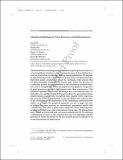Likelihood Methods for Point Processes with Refractoriness
Author(s)
Citi, Luca; Brown, Emery N.; Barbieri, Riccardo; Ba, Demba E.
DownloadCiti-2013-Likelihood Methods f.pdf (907.1Kb)
PUBLISHER_POLICY
Publisher Policy
Article is made available in accordance with the publisher's policy and may be subject to US copyright law. Please refer to the publisher's site for terms of use.
Terms of use
Metadata
Show full item recordAbstract
Likelihood-based encoding models founded on point processes have received significant attention in the literature because of their ability to reveal the information encoded by spiking neural populations. We propose an approximation to the likelihood of a point-process model of neurons that holds under assumptions about the continuous time process that are physiologically reasonable for neural spike trains: the presence of a refractory period, the predictability of the conditional intensity function, and its integrability. These are properties that apply to a large class of point processes arising in applications other than neuroscience. The proposed approach has several advantages over conventional ones. In particular, one can use standard fitting procedures for generalized linear models based on iteratively reweighted least squares while improving the accuracy of the approximation to the likelihood and reducing bias in the estimation of the parameters of the underlying continuous-time model. As a result, the proposed approach can use a larger bin size to achieve the same accuracy as conventional approaches would with a smaller bin size. This is particularly important when analyzing neural data with high mean and instantaneous firing rates. We demonstrate these claims on simulated and real neural spiking activity. By allowing a substantive increase in the required bin size, our algorithm has the potential to lower the barrier to the use of point-process methods in an increasing number of applications.
Date issued
2014-01Department
Massachusetts Institute of Technology. Department of Brain and Cognitive SciencesJournal
Neural Computation
Publisher
MIT Press
Citation
Citi, Luca, Demba Ba, Emery N. Brown, and Riccardo Barbieri. “Likelihood Methods for Point Processes with Refractoriness.” Neural Computation 26, no. 2 (February 2014): 237-263. © 2014 Massachusetts Institute of Technology
Version: Final published version
ISSN
0899-7667
1530-888X